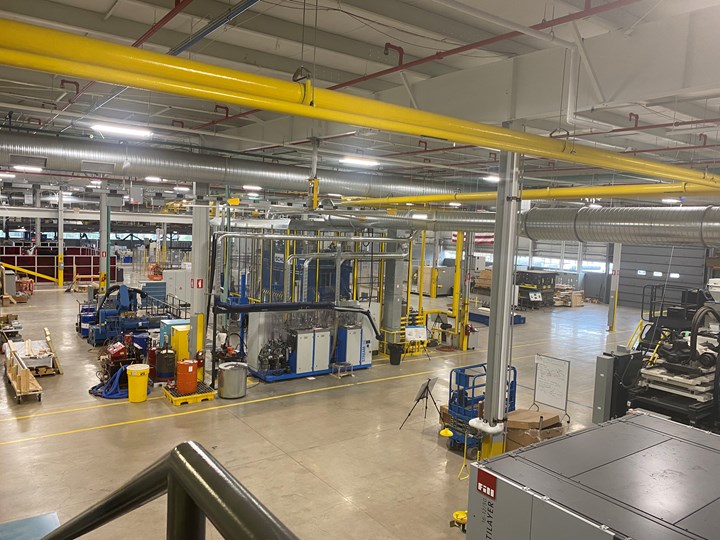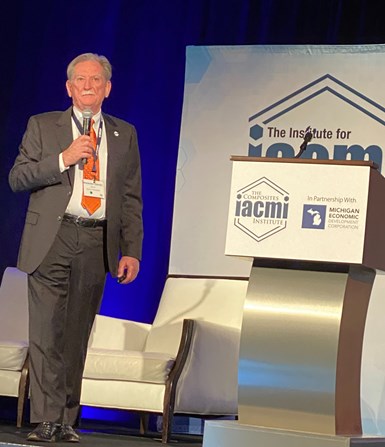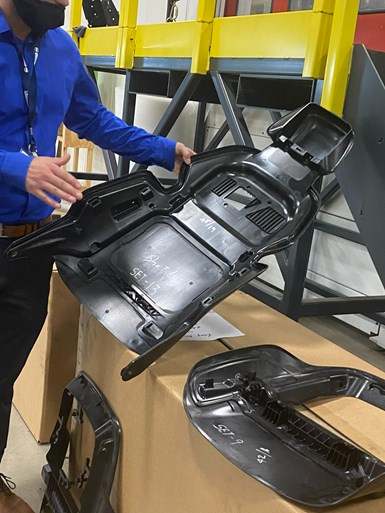
As part of its Oct. 5-7 Fall Members Meeting, IACMI led members on a tour of its Scale-Up Research Facility (SURF) in Detroit, Mich., U.S., explaining the ways members and partners can use the facility’s capabilities for their research efforts.
The Institute for Advanced Composites Manufacturing Innovation (IACMI, Knoxville, Tenn., U.S.) held its Fall 2021 Members Meeting in Dearborn, Mich., U.S. on Oct. 5-7. According to Dale Brosius, chief commercialization officer at IACMI, it’d been 622 days since the last in-person IACMI Members Meeting in January 2020.
A few themes running throughout speaker presentations were the role of composites in the U.S. automotive industry, workforce development and the next generation of composites professionals, and a focus on sustainability throughout every market the composites industry serves.
Event speakers: Automotive innovation, workforce development
These themes were amplified by the four featured speakers. Sandy Munro, CEO of (Auburn Hills, Mich., U.S.), discussed paradigm shifts within automotive manufacturing, and how U.S. automakers should

Among the Members Meeting speakers, featured speaker Sandy Munro explained how electric vehicles (EV) are causing a paradigm shift in automotive manufacturing.
shift design thinking toward composites-intensive electric vehicles (EV) and even electric vertical takeoff and landing (eVTOL) aircraft to compete in the global transportation market. “Past success means nothing when the paradigm changes,” he said.
U.S. Representative Haley Stevens (D-Mich.) applauded the way Michigan manufacturers have stepped up since the beginning of the pandemic, and noted her and Congress’ ongoing efforts to solve supply chain issues. “What’s the moonshot of the next 50 years? It’s vehicular technology. It’s what you’re all working on,” she said. “Part of what we’re all doing is propelling innovation forward — we can’t rest a beat!”
Satish Udpa, professor of electrical and computer engineering at Michigan State University (MSU, East Lansing), introduced various mobility-related R&D projects that MSU is working on, including composites projects related to vehicle lightweighting, recyclability, rapid joining technologies and vehicle structural health monitoring.
Brent Strong, chief technology officer of the (UAMMI), spoke about the ways UAMMI is connecting companies along the supply chain within Utah, developing the next-generation workforce through high school and college programs, and enabling research efforts into various sectors of the industry.
Additional speakers during the conference included John Hopkins, CEO of IACMI; Josh Hundt, executive VP and chief business development officer at the Michigan Economic Development Corp.; Joe Fox, consultant at FX Consulting; Scott Blake, president of Aligned Vision; Matthew Pais, modeling and simulation director at Dassault Systèmes; Andrew Maxey, CEO of Vartega; Joannie Harmon, workforce director at IACMI; Hicham Ghossein, CEO, president and founder of Endeavor Composites; Christopher Oberste, founder and CEO of WEAV3D Inc. and more.
A panel including Scott Stephenson, director of strategic events and initiatives at ÂÌñÏ×ÆÞ; Raj Manchanda, CTO at SAMPE; Dan Coughlin, VP of composites market development at ACMA; and Uday Vaidya, CTO at IACMI discussed ways these organizations can unite efforts to develop the composites workforce and solve industry challenges.
Working Groups and IACMI projects
IACMI’s Working Groups, begun in 2020 and including industry representatives spanning the supply chain for various topics and markets, also met during the week and group leaders presented summaries of each group’s activities. All six Working Groups — Infrastructure/Construction, Recycling/Circular Economy, High-Rate Aerostructures Fabrication, Simulation/Digital Twin, Future Mobility/Vehicles Technology, and Wind Energy — aim to connect industry leaders and move innovation forward. Those interested in participating in future Working Group meetings, either in-person or virtually, can find more information at .

As part of IACMI Project 3.9, Dura Automotive Systems used the IACMI SURF facility’s FILL multi-layer tape laying system and Milacron injection molding machine to build preforms and prototypes of its composite seatback.
Three IACMI-funded projects were also showcased. Indraneel Page, innovations supervisor – structures and exteriors at (Auburn Hills, Mich., U.S.), presented an ongoing project to develop a layup and preforming process using continuous fiber tapes at high speeds suitable for the automotive industry. Using a first-row seat design and parameters from partner Ford, Dura Automotive designed a composite seat back structure and cushion pan said to reduce weight by 29% and number of parts by 28% compared to the original Ford design. Dura Automotive built 2D preforms using BASF Ultratape on a FILL tape-laying machine at IACMI’s Scale-Up Research Facility (SURF), and additional features were added via injection overmolding. Page said additional trials and testing were ongoing.
Vartega’s (Golden, Colo., U.S.) Maxey introduced a project using the same Ford seatback design and tooling from Dura Automotive, built via recycled carbon fiber (rCF) and thermoplastic injection molded pellets. The current design uses rCF and PA6, Maxey said, and initial results are expected to be published soon.
MSU’s Mahmood Haq and Oleksii Karpenko presented work they and their research teams are doing to develop high-speed nondestructive testing (NDI) for composite parts. The work involves both hardware development such as robotic platform and a gantry system, and scanning software. The teams are also working to develop capacitative and hybrid inductive/capacitive electromagnetic sensors, and hope to translate the technology into use by the automotive industry for part inspection.
IACMI SURF facility tour
Finally, the meeting capped with a tour of IACMI’s Scale-Up Research Facility (SURF) in the Corktown neighborhood of Detroit. Visitors had an opportunity to see the facility’s capabilities, including a hot-melt prepreg line, BASF 3D printing labs and equipment, FILL multi-layer tape laying machine, Milacron injection molding machine and Schuler compression press with high-pressure resin transfer molding (HP-RTM) capabilities.
For information on future IACMI Members Meetings, visit .
Related Content
SMC composites progress BinC solar electric vehicles
In an interview with one of Aptera’s co-founders, CW sheds light on the inspiration behind the crowd-funded solar electric vehicle, its body in carbon (BinC) and how composite materials are playing a role in its design.
Read MoreCarbon fiber, bionic design achieve peak performance in race-ready production vehicle
Porsche worked with Action Composites to design and manufacture an innovative carbon fiber safety cage option to lightweight one of its series race vehicles, built in a one-shot compression molding process.
Read MoreBraided thermoplastic composite H2 tanks with co-consolidated molded boss areas to fit EV battery space
BRYSON project demonstrates possible designs, automated manufacturing and low permeability concepts, including EVOH liner and novel PPA matrix.
Read MoreCo-molding SMC with braided glass fiber demonstrates truck bed potential
Prepreg co-molding compound by IDI Composites International and A&P Technology enables new geometries and levels of strength and resiliency for automotive, mobility.
Read MoreRead Next
Ultrasonic welding for in-space manufacturing of CFRTP
Agile Ultrasonics and NASA trial robotic-compatible carbon fiber-reinforced thermoplastic ultrasonic welding technology for space structures.
Read MoreNext-gen fan blades: Hybrid twin RTM, printed sensors, laser shock disassembly
MORPHO project demonstrates blade with 20% faster RTM cure cycle, uses AI-based monitoring for improved maintenance/life cycle management and proves laser shock disassembly for recycling.
Read MoreCutting 100 pounds, certification time for the X-59 nose cone
Swift Engineering used HyperX software to remove 100 pounds from 38-foot graphite/epoxy cored nose cone for X-59 supersonic aircraft.
Read More
.jpg;width=70;height=70;mode=crop)












